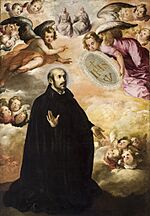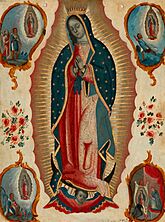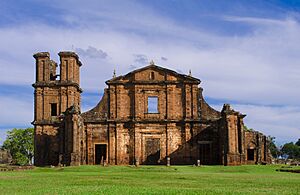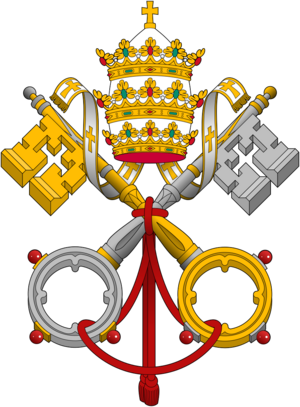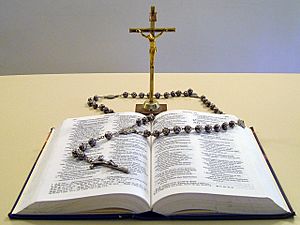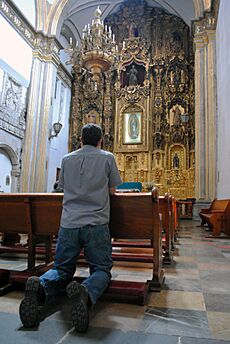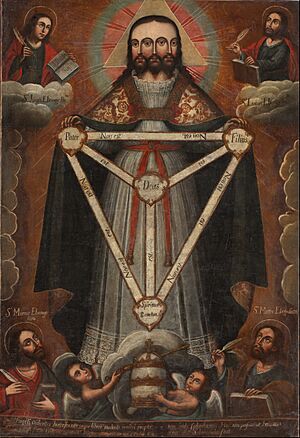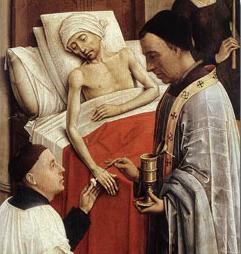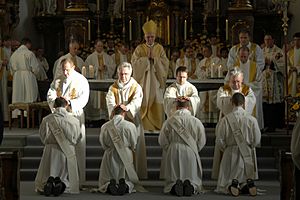Catholic Church facts for kids
Quick facts for kids Catholic Church |
|
|---|---|
| Ecclesia Catholica | |
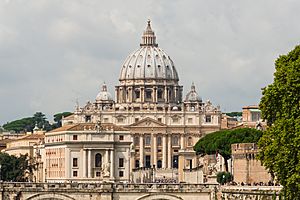
St. Peter's Basilica in Vatican City, the largest Catholic church building in the world
|
|
| Classification | Catholic |
| Scripture | Catholic Bible |
| Theology | Catholic theology |
| Polity | Episcopal |
| Governance | Holy See and Roman Curia |
| Pope | Francis |
| Particular churches sui iuris |
Latin Church and 23 Eastern Catholic Churches |
| Dioceses |
|
| Parishes | 221,700 approx. |
| Region | Worldwide |
| Language | Ecclesiastical Latin and native languages |
| Liturgy | Latin and Eastern |
| Headquarters | Vatican City |
| Founder |
|
| Origin | 1st century Roman Empire |
| Separations |
|
| Members | 1.272 billion according to World Christian Database (2025) 1.406 billion according to the Annuario Pontificio (2023) |
| Clergy |
|
| Hospitals | 18,000 clinics 5,500 hospitals |
| Nursing homes | 16,000 |
| Primary schools | 95,200 |
| Secondary schools | 43,800 |
The Catholic Church (Latin: Ecclesia Catholica), also known as the Roman Catholic Church, is the largest Christian church in the world. It has about 1.4 billion members globally. It is one of the oldest and biggest international groups. The Church has greatly shaped the history and growth of Western civilization.
The Catholic Church includes 24 different self-governing churches. These are the Latin Church and 23 Eastern Catholic Churches. Together, they have almost 3,500 dioceses and eparchies worldwide. Each is led by one or more bishops. The pope, who is the bishop of Rome, is the main leader of the entire Church.
Catholics believe in the core ideas found in the Nicene Creed. The Church teaches that it is the one, holy, catholic, and apostolic church. It believes Jesus Christ founded it. Its bishops are seen as the successors of Christ's apostles. The pope is believed to be the successor of Saint Peter. The Church teaches that it keeps the original Christian faith. This faith was taught by the apostles. It is preserved through scripture and sacred tradition.
The main ceremony is the Eucharist, celebrated in the Mass. The Church teaches that during Mass, bread and wine become the body and blood of Christ. This happens through a priest's special prayer. The Virgin Mary is highly honored as the Mother of God. She is celebrated in special teachings and prayers. The Church also focuses on helping the sick, the poor, and those in need. It does this through charitable actions. The Catholic Church runs many schools, universities, hospitals, and orphanages. It is the largest non-government provider of education and health care globally.
The Catholic Church has deeply influenced Western philosophy, culture, art, and science. Catholics live all over the world. Many now live in the Global South. This is partly because of changes in Europe and North America. The Catholic Church was once united with the Eastern Orthodox Church. They separated in 1054 in the East–West Schism. This was mainly due to disagreements about the pope's authority. In the 16th century, the Reformation led to the creation of Protestant groups.
The Diocese of Rome is led by the pope. The Holy See is the central governing body of the Catholic Church. Its main offices are in Vatican City. This is a small, independent city-state in Rome. The pope is its head of state.
The Catholic Church: A Global Community
What Does "Catholic" Mean?
The word Catholic comes from a Greek word meaning "universal." It was first used to describe the Church in the early 2nd century. Saint Ignatius of Antioch used the phrase "the catholic church" around 110 AD. He wrote that wherever the bishop is, there the universal Church is.
Later, in 350 AD, Saint Cyril of Jerusalem used "Catholic Church." This helped tell it apart from other groups. In 380 AD, Emperor Theodosius I made Nicene Christianity the official religion of the Roman Empire. He also stressed the "Catholic" idea.
After the East–West Schism in 1054, the Eastern Orthodox Church used the name Orthodox. The Latin Church kept the name Catholic. After the Protestant Reformation in the 16th century, those who stayed with the pope were called Catholics.
The term Roman Catholic Church has been used in English since the 16th century. It describes the entire Church. The official documents of the Church, like the Catechism of the Catholic Church, use the name Catholic Church.
A Look Back: The Church's Journey
Early Days and Apostles
The New Testament tells us about Jesus' life and teachings. It also describes how he chose his Twelve Apostles. Jesus told them to continue his work. The book of Acts of Apostles describes the start of the Christian church. It shows how its message spread in the Roman Empire.
The Catholic Church believes its public work began on Pentecost. This was 50 days after Jesus' resurrection. On Pentecost, the apostles received the Holy Spirit. This prepared them to lead the Church. The Church teaches that its bishops are the successors of these apostles. The bishop of Rome, the pope, is seen as the successor to Saint Peter.
Growth in the Roman Empire
The Roman Empire helped new ideas spread. Its roads and waterways made travel easy and safe. The empire also shared a common culture. This helped people understand new messages.
Christians had to worship only one God. This was different from most Roman religions. Their refusal to join pagan celebrations caused problems. Non-Christians feared Christians were angering the gods. This led to times of persecution.
In 313, Emperor Constantine the Great made Christianity legal. He was the first Roman emperor to become Christian. In 380, Nicene Christianity became the official state religion. This helped the Church grow even more.
Middle Ages and New Ideas
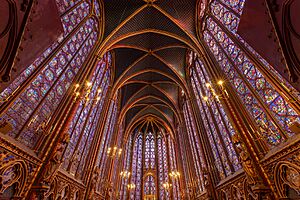
The Catholic Church was very important in Western civilization for many centuries. It supported many art styles, like Romanesque and Gothic. Famous artists like Michelangelo and Leonardo da Vinci were supported by the Church. Historians say the Church was central to developing Western values and ideas.
Monks in Europe started the first universities. Many older cathedral schools became universities. Examples include the University of Oxford and the University of Paris. These schools expanded learning beyond religious studies.
In the 7th century, Islamic invasions began. This led to long conflicts in the Mediterranean. The Frankish state in Western Europe grew stronger. It became a major power.
In 754, the Frankish king Pepin the Short gave lands to the pope. This started the Papal States. These were territories ruled by the pope. In the 11th century, the College of Cardinals was created. This group elects new popes.
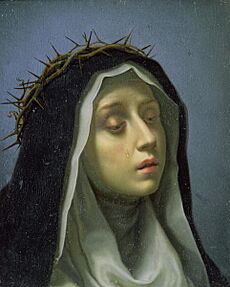
Around the 12th century, special Church courts called inquisitions began. They responded to certain religious groups. These courts used methods common in secular courts at the time.
New religious orders like the Franciscans and Dominicans started in the early 13th century. They played a big role in developing universities. Scholars like Thomas Aquinas taught at these schools. His writings combined ancient Greek ideas with Christian faith.
The 14th century saw conflicts between Church and state. Popes lived in Avignon, France, for a time. Later, a period called the Western Schism occurred. Different people claimed to be the pope. This was resolved at the Council of Constance in 1418.
Exploring New Worlds and Changes
The Age of Discovery began in the 15th century. European nations like Spain and Portugal explored the world. Catholicism spread to the Americas, Asia, and Oceania. Explorers and missionaries shared their faith. For example, Ferdinand Magellan brought Catholicism to the Philippines in 1521.
In the 16th century, the Reformation began. Martin Luther and others questioned some Catholic teachings. This led to the creation of many Protestant groups. In England, King Henry VIII separated from the pope. This started the English Reformation.
The Church responded with the Counter-Reformation. The Council of Trent (1545–1563) reaffirmed many Catholic beliefs. It stressed the importance of sacraments and good deeds. Catholicism continued to spread globally through missionaries.
Modern Times and Global Reach
From the 17th century, the Age of Enlightenment questioned the Church's influence. Writers criticized religion and the Church. The French Revolution in 1789 caused churches to be destroyed. It also led to the persecution of religious people. Napoleon later restored the Catholic Church in France.
In 1854, Pope Pius IX declared the Immaculate Conception as a dogma. This means it is a central belief. In 1870, the First Vatican Council affirmed papal infallibility. This means the pope cannot be wrong on certain matters of faith.
The Italian unification in the 1860s ended the pope's rule over the Papal States. The pope became a "prisoner in the Vatican". This issue was resolved in 1929. The Lateran Treaty created Vatican City as an independent state.
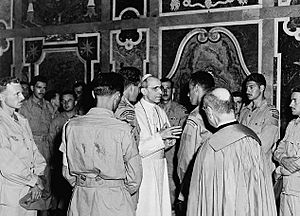
In the 20th century, the Church's global reach grew. Popes Benedict XV and Pius XII worked for peace during the World Wars. In the 1960s, Pope John XXIII called the Second Vatican Council. This council brought big changes to Church practices.
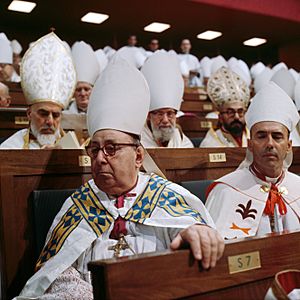
The Second Vatican Council (1962–65) updated many Church practices. It allowed Mass to be said in local languages. It encouraged people to take a more active part in worship. The council also improved relations with other Christian and non-Christian religions.
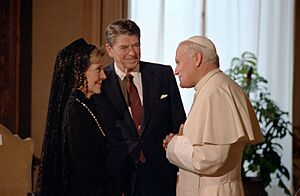
In 1978, Pope John Paul II became the first non-Italian pope in 455 years. His long time as pope helped end communism in Europe. He traveled widely and used media to share Church teachings. He also spoke about the importance of fair work and wages.
Pope Benedict XVI, elected in 2005, upheld traditional Christian values. He resigned in 2013 due to old age. This was the first papal resignation in nearly 600 years.
Pope Francis became pope in 2013. He was the first pope from the Americas. He worked to improve relations with Eastern churches. He met with leaders of the Eastern Orthodox Church. In 2017, he re-established mutual recognition of baptism with the Coptic Orthodox Church.
Pope Leo XIV was elected Pope in the 2025 papal conclave. He is the 267th pope of the Catholic Church. He is the first Augustinian pope and the first North American pope. He was born in Chicago in the United States and holds Peruvian citizenship.
How the Church is Organized
The Catholic Church is led by bishops. They receive a special sacrament called Holy Orders. Bishops oversee a geographic area called a diocese. There are three levels of clergy: bishops, priests, and deacons. Priests are ordained by bishops and work in dioceses. Deacons help bishops and priests. The bishop of Rome, known as the pope, leads the entire Church. His authority is called the Holy See.
Many religious groups also exist. They often answer directly to the pope. These groups have male or female members. Lay members (non-clergy) also help in many Church services. The Catholic Church is often called the oldest multinational organization.
The Pope and the Holy See
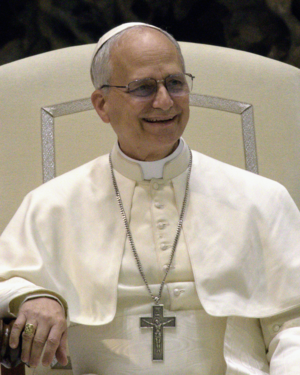
The pope, currently Pope Leo XIV, leads the Catholic Church. He was elected on 8 May 2025. Catholics believe Christ established the papacy. He gave the keys of Heaven to Saint Peter. The pope's authority is called the Holy See. The Roman Curia helps the pope manage the Church's daily business.
The pope is also the leader of Vatican City. This is a small independent state within Rome. The pope acts as head of the Holy See. In this role, he meets with ambassadors from other countries.
Cardinals are important Church leaders. Popes give them this title. They include leaders in the Roman Curia and bishops of major cities. The pope can ask the College of Cardinals for advice. When a pope dies or resigns, cardinals under 80 years old elect a new pope. They meet in a special gathering called a papal conclave.
Rules and Guidelines: Canon Law
Canon law is the system of rules for the Catholic Church. These laws help organize the Church. They also guide Catholics in their faith. Canon law for the Latin Church is the oldest continuously working legal system in the West. Eastern Catholic Churches have their own distinct canon law traditions.
These laws cover many aspects of Church life. They include how the Church is governed. They also cover how Catholics should live their faith. Canon law has courts, lawyers, and judges. It also has a full legal code for both Latin and Eastern Churches.
Canon law is different from civil law. It only applies civil law in specific cases. Similarly, civil law may apply canon law in its own field. This happens, for example, with canonical marriages. The current code for the Latin Church is the 1983 Code of Canon Law. The Eastern Catholic Churches follow the Code of Canons of the Eastern Churches.
Different Rites, One Faith
In the first thousand years, different Christian traditions grew. These developed in Western and Eastern Europe, Asia, and Africa. Today, 23 self-governing Eastern Catholic Churches are part of the Catholic Church. They are called "churches sui iuris" (meaning "of one's own right"). The largest is the Latin Church, with over 1 billion members.
The Latin Church is led by the pope and bishops he appoints. It represents the main part of Western Christianity. This includes beliefs and customs from Europe and Northwest Africa.
The Eastern Catholic Churches follow Eastern Christianity traditions. They have always been in full communion with the pope. Or they rejoined communion after past divisions. These churches have different ways of worship. These reflect their history and culture. But their core beliefs are the same.
The pope recognizes these Eastern Catholic Churches. This has sometimes caused discussions with Eastern Orthodox churches. The Second Vatican Council confirmed the right of Eastern Catholics to keep their unique practices.
Local Churches and Communities
Individual countries and cities have local churches. These are called dioceses in the Latin Church. They are called eparchies in the Eastern Catholic Churches. Each is led by a bishop. As of 2021, there are 3,171 dioceses worldwide. Bishops in a country form a national conference.
Dioceses are divided into parishes. Each parish has one or more priests or deacons. Parishes celebrate the sacraments daily. They also provide care for their members. As of 2016, there are about 221,700 parishes globally.
Catholic men can become deacons or priests. They receive ordination. Men and women can serve in other roles. These include helping with Communion or reading during services. Girls and women have been allowed to be altar servers since the 1990s.
Catholics can also choose a consecrated life. They can become hermits or join religious groups. These groups take vows of chastity, poverty, and obedience. Examples include the Benedictines, Carmelites, and Missionaries of Charity.
The Catholic Church is the largest non-government provider of education and medical services. It runs thousands of schools, colleges, and hospitals worldwide.
What Catholics Believe
Catholic beliefs have grown over centuries. They reflect teachings from early Christians. They also include definitions from Church councils and popes. The Church believes it is guided by the Holy Spirit. It is protected from error in its teachings.
The Church teaches that God is the source of all revelation. This revelation comes through two ways. These are Sacred Scripture (the Bible) and Sacred Tradition. The Catholic Bible has 73 books. The Church's teaching authority, called the Magisterium, interprets these.
God and the Trinity
The Catholic Church believes in one eternal God. This God exists as three "persons": God the Father, God the Son (Jesus Christ), and God the Holy Spirit. Together, they are called the "Holy Trinity."
Catholics believe Jesus Christ is God the Son. Through the Holy Spirit, God became human. This happened when Christ was conceived in the womb of the Blessed Virgin Mary. So, Christ is fully divine and fully human. His mission was to teach people and show them how to live. Jesus lived without sin. He allowed himself to be crucified. This was a sacrifice to bring humanity back to God. This is called the Paschal Mystery.
The Church teaches that the Holy Spirit comes from the Father and the Son. This belief is in the Filioque clause of the Nicene Creed.
The Church's Role
The Catholic Church teaches it is the "one true church." It is seen as the "universal sacrament of salvation." The Nicene Creed describes it as "one, holy, catholic, and apostolic." These are the Four Marks of the Church. The Church believes Jesus Christ founded it.
The New Testament shows how Jesus established the Church. He appointed the apostles to continue his work. The coming of the Holy Spirit at Pentecost marked the start of the Church's public ministry. The Church teaches that bishops are successors of the apostles. The pope, as Bishop of Rome, is the successor of Simon Peter. He has supreme authority over the Church.
Catholics believe the Church is "the continuing presence of Jesus on earth." It offers the full means of salvation. Through Christ's suffering and crucifixion, he reconciled humanity to God. His Resurrection of Jesus offers new life. By following Christ, people can enter the Kingdom of God. The Church's ceremonies and sacraments help strengthen this relationship.
Life After Death
The Catholic Church teaches that after death, each person's soul is judged by God. This is based on their actions and faith. The Church also believes in a final judgment for all humanity. This will mark the end of human history. It will begin a new heaven and earth ruled by God.
Souls may enter one of three states after death:
- Heaven is an unending union with God. It is a state of eternal happiness.
- Purgatory is a temporary state. Souls are purified there before entering Heaven. Prayers from people on earth can help souls in Purgatory.
- Final Damnation is for those who reject God. It is an everlasting separation from God. The Church teaches that no one is sent to hell without choosing to reject God.
The Church teaches that it offers the full means of salvation. However, it also recognizes that God's grace can work in other Christian communities. People can also be saved through baptism of desire or baptism of blood. Even those who don't know Christ or the Church can find salvation. This is if they seek God with a sincere heart.
Saints and Special Prayers
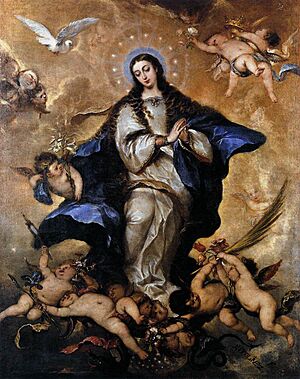
A saint is a person known for great holiness or closeness to God. Canonization is when the Church officially declares someone a saint. The first saints were martyrs (people who died for their faith). Later, "confessors" (those who suffered for their faith) were also honored.
In the Catholic Church, only the pope can canonize a saint. This follows a long process. It requires much proof of a holy life. Being recognized as a saint means the person is in Heaven. They can be publicly honored in Church prayers.
Devotions are special prayers and practices. They are not part of the official Mass. They include honoring saints, especially the Virgin Mary. Other devotions are the Stations of the Cross and the Rosary. The Church encourages these practices. It reminds Catholics that they should lead to the official liturgy.
Honoring Mary, Mother of Jesus
Catholic Mariology includes teachings about Mary, mother of Jesus. It also covers how Catholics honor her. Mary is highly respected. She is called the Mother of God. Catholics believe she remained a virgin throughout her life.
Other important beliefs about Mary include the Immaculate Conception. This means she was conceived without original sin. The Assumption of Mary teaches that her body was taken directly to heaven. These beliefs were declared by popes after consulting with bishops. Eastern Catholic churches celebrate the Dormition of the Mother of God, which is similar to the Assumption.
Devotions to Mary are a big part of Catholic prayer. These include prayers like the Hail Mary and the Rosary. Many churches and artworks honor Mary. Pilgrimages to places like Lourdes and Fátima are also popular. Pope Paul VI called Mary the Mother of the Church. This is because she gave birth to Christ.
Important Ceremonies: The Seven Sacraments
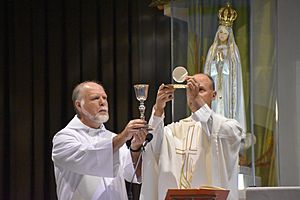
The Catholic Church teaches that Christ gave it seven sacraments. These were defined by Church councils. They are Baptism, Confirmation, the Eucharist, Penance, Anointing of the Sick, Holy Orders, and Holy Matrimony. Sacraments are visible rituals. Catholics see them as signs of God's presence. They are channels of God's grace.
The Catechism of the Catholic Church groups sacraments into three types. These are "sacraments of Christian initiation," "sacraments of healing," and "sacraments at the service of communion." These groups reflect different stages of life.
The liturgies of the sacraments are central to the Church. They are encounters between Christ and the Church. The Church teaches that sacraments need proper form, matter, and intention to be valid. There are also rules about who can celebrate and receive them. For example, Catholics in serious sin should not receive the Eucharist. They should first go to sacrament of Reconciliation (Penance).
Becoming a Christian: Initiation Sacraments
Baptism

Baptism is the first of the three sacraments of initiation. It washes away all sins. It makes a person a member of the Church. It is a gift from God. It is given even to babies. They need it because of original sin.
If a baby is in danger of death, anyone can baptize them. This includes a doctor, nurse, or parent. Baptism marks a person permanently. It cannot be repeated. The Catholic Church recognizes baptisms by non-Catholics as valid. This is if they intend to baptize as the Church does. They must use the Trinitarian baptismal formula.
Confirmation
Confirmation completes the grace given in baptism. Adults usually receive confirmation right after baptism. Eastern Catholic Churches also confirm babies after baptism. In Western churches, children are confirmed when they are older. This is when they can understand the sacrament.
In the West, it is called confirmation because it strengthens baptismal grace. In the East, it is chrismation. This involves anointing with chrism oil. Those receiving confirmation must be in a state of grace. They should also intend to receive it. They must be ready to live as Christians.
Eucharist
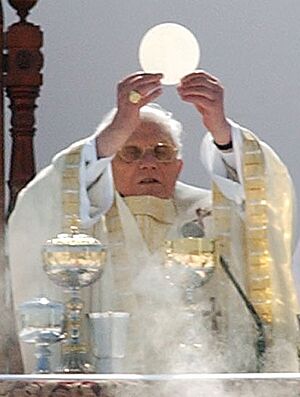
For Catholics, the Eucharist completes Christian initiation. It is called "the source and summit of the Christian life." The first time a Catholic receives the Eucharist is called First Communion.
The Eucharistic celebration is also called the Mass. It includes prayers and Bible readings. Bread and wine are offered. A priest consecrates them to become the body and blood of Jesus Christ. This change is called transubstantiation. The words of consecration come from Jesus at the Last Supper. The sacrament makes Jesus' sacrifice on the cross present again. It unites believers with Christ. It helps forgive minor sins. It also helps avoid serious sins.
Healing and Forgiveness: Healing Sacraments
Penance (Confession)
The Sacrament of Penance is also called Reconciliation or Confession. It is for those who have sinned after baptism. It helps them return to Christ. The sinner must examine their conscience. They must be sorry for their sins. They must intend not to sin again. They must confess to a priest. They also perform an act of reparation. The priest determines this act and gives absolution.
Serious sins should be confessed at least once a year. They must be confessed before receiving Holy Communion. Confessing minor sins is also recommended. Priests must keep all confessions secret. This is called the "seal of confession."
Anointing of the Sick
A priest or bishop uses a special oil to bless sick or elderly Catholics. This is when they are in danger of death. This sacrament is called Anointing of the Sick. It brings comfort, peace, and courage. It can also forgive sins if the person cannot confess.
This sacrament is also called Unction. In the past, it was Extreme Unction. It is one of the three sacraments of the last rites. The others are Penance and Viaticum (Eucharist).
Serving Others: Sacraments of Service
The Catechism describes two sacraments for serving others. These are priesthood and marriage. They prepare people for specific missions among God's people. Men receive holy orders to serve the Church. Spouses marry to strengthen their love and duties.
Holy Orders (Priesthood)
The sacrament of Holy Orders dedicates Christians to serve the Church. There are three levels: bishops, priests, and deacons. The Church has rules about who can be ordained. In the Latin Church, only celibate men can be priests. Only celibate men can be bishops. Married men can be ordained in some Eastern Catholic churches. They can also become deacons in the Latin Church. Once a man becomes a Catholic priest, he cannot marry.
All clergy can preach, teach, baptize, and witness marriages. They can also conduct funerals. Only bishops and priests can administer the Eucharist, Penance, and Anointing of the Sick. Only bishops can administer Holy Orders.
Matrimony (Marriage)
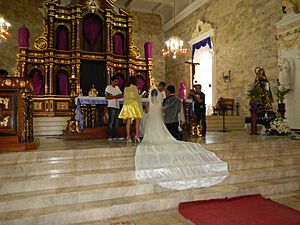
The Catholic Church teaches that marriage is a special bond between a man and a woman. It is for the good of the couple and for having children. A Catholic marriage, or any marriage between baptized Christians, is a sacrament. A sacramental marriage, once completed, cannot be ended except by death. The Church requires certain conditions for a valid marriage. These include free consent. The Church also has specific rules for Catholics, called canonical form.
The Church does not recognize divorce as ending a valid marriage. It allows civil divorce only to protect the family. However, a Church court can declare a marriage invalid. This is called an annulment. It means the marriage was not valid from the start. Remarriage after a divorce is not allowed unless the first marriage was annulled.
Ways of Worship: Liturgy
Among the 24 self-governing churches, there are many different traditions. These are called rites. They show historical and cultural diversity. They do not mean differences in belief. A rite includes the worship, theology, and customs of a people.
The main worship service is the Eucharist. It is called the Mass in the West. It is called Divine Liturgy or other names in the East. This is because it is seen as the sacrifice of Christ. Eastern Catholic Churches have their own rites. Their liturgies vary, showing different theological ideas.
Western Rites
The Roman Rite is the most common way of worship. It is used by the Catholic Church worldwide. It started in Rome and spread throughout Europe. The current form of the Mass is usually celebrated in local languages. It uses approved translations from the original Latin.
This form of Mass was approved by Pope Paul VI in 1969. It was revised by Pope John Paul II in 2001. In some cases, an older form of the Roman Rite from 1962 is still used.
In the Roman Catholic Archdiocese of Milan, Mass is celebrated using the Ambrosian Rite. Other Latin Church rites also exist. These include the Mozarabic Rite. These older rites were allowed to continue.
Eastern Rites
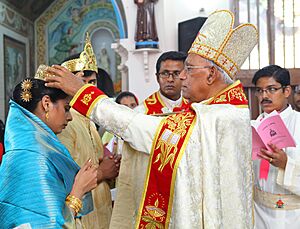
The Eastern Catholic Churches share traditions with other Eastern Christian churches. These include churches that developed in Russia, the Balkans, India, and the Middle East. Eastern Catholic Churches are in full communion with the pope.
The liturgical rites of the Eastern Catholic Churches include the Byzantine Rite and the Alexandrian Rite. These churches can set their own worship forms. They must protect their liturgical traditions.
In the past, some Eastern Catholic rites adopted Western practices. Recently, they have returned to traditional Eastern ways. This is in line with the Second Vatican Council decree Orientalium Ecclesiarum. Each church also has its own liturgical calendar.
Caring for the World: Social Teachings
Helping Others
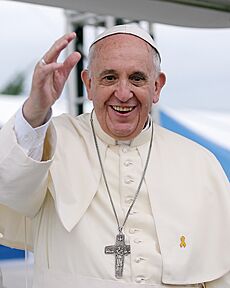
Catholic social teaching emphasizes helping the poor and sick. This reflects Jesus' concern for those in need. The Church calls for a special focus on the poor. Canon law states that Christians must promote social justice. They must also help the poor. These teachings began with Pope Leo XIII's 1891 letter Rerum novarum. It supported the rights of workers.
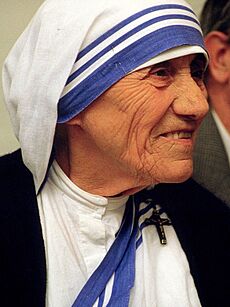
The Catholic Church is the largest non-government provider of education and medical services. In 2010, the Church managed 26% of health care facilities worldwide. This includes hospitals, clinics, and orphanages.
The Church has always been involved in education. It runs thousands of schools and universities globally. Religious women's groups have been very important in health and education. Orders like the Sisters of Mercy and the Missionaries of Charity have done great work. Mother Teresa won the Nobel Peace Prize in 1979 for her work with the poor in India.
The Church also provides international aid. Organizations like Catholic Relief Services and Caritas Internationalis help people in need. They assist refugees and communities.
Protecting Our Planet
The Church also teaches about caring for the natural environment. This is connected to other social teachings. In 2015, Pope Francis wrote Laudato si'. This letter criticized over-consumption and irresponsible development. It spoke about environmental degradation and climate change. The pope worried that the developed world was ignoring the planet's destruction. He called for better care for our common home.
Images for kids
-
An allegory of virtues by Hans Memling.
-
Pope Paul VI issued Humanae vitae in 1968.
See also
 In Spanish: Iglesia católica para niños
In Spanish: Iglesia católica para niños
- Catholic Church and politics
- Catholic Church and race
- Catholic art
- Catholic culture
- Catholic peace traditions
- Glossary of the Catholic Church
- List of Catholic religious institutes
- Liturgical year of the Catholic Church
- Lists of Catholics
- List of popes
- Role of Christianity in civilization
- Society of Jesus




